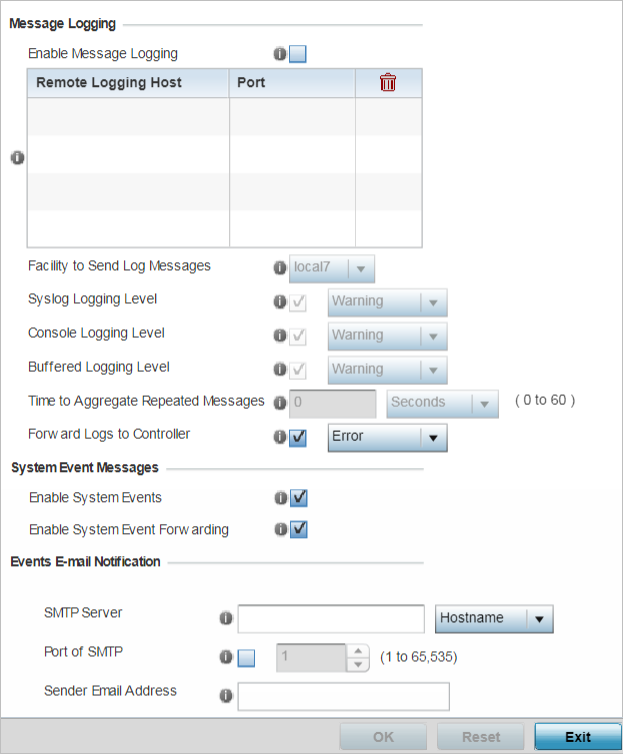There are mechanisms to allow or deny management access to the network for separate interfaces and protocols: HTTP, HTTPS, Telnet, SSH, and SNMP.
These management access configurations can be applied strategically to profiles as resource permissions dictate for the profile. Additionally, overrides can be applied to customize a device‘s management configuration, if deployment requirements change and a device's configuration must be modified from its original device profile configuration.
Additionally, an administrator can define a profile with unique configuration file and device firmware upgrade support. You can override the management configurations of a profile at the device level. To override an access point profile's management settings:
To define or override a profile‘s management configuration:
The selected access point's profile configuration menu displays.

Note
A blue override icon (to the left of a parameter) defines the parameter as having an override applied. To remove an override go to the Basic Configuration section of the device and click Clear Overrides. This removes all overrides from the device.
The management Settings configuration screen displays.

Selecting this check box enables the rest of the parameters required to define the profile‘s logging configuration. This option is disabled by default.
|
Remote Logging Host |
Define numerical (non DNS) IP addresses for up to four external resources where logged system events can be sent by the access point. Select the trash icon as needed to remove an IP address from the list. |
|
Port |
Define the ports at which the external resources are reachable. |
|
Facility to Send Log Messages |
Use the drop-down menu to specify the local server (if used) for access point event log transfers. |
|
System Logging Level |
Event severity coincides with the syslog logging level defined for the profile. Assign a numeric identifier to log events based on criticality. Severity levels include: 0 - Emergency, 1 - Alert, 2 - Critical, 3 - Errors, 4 - Warning, 5 - Notice, 6 - Info and 7 - Debug. The default logging level is 4 - Warning. |
|
Console Logging Level |
Event severity coincides with the syslog logging level defined for the profile. Assign a numeric identifier to log events based on criticality. Severity levels include: 0 - Emergency, 1 - Alert, 2 - Critical, 3 - Errors, 4 - Warning, 5 - Notice, 6 - Info and 7 - Debug. The default logging level is 4 - Warning. |
|
Buffered Logging Level |
Event severity coincides with the syslog logging level defined for the profile. Assign a numeric identifier to log events based on criticality. Severity levels include: 0 - Emergency, 1 - Alert, 2 - Critical, 3 - Errors, 4 - Warning, 5 - Notice, 6 - Info and 7 - Debug. The default logging level is 4 - Warning. |
|
Time to Aggregate Repeated Messages |
Define the increment (or interval) system events are logged on behalf of the access point. The shorter the interval, the sooner the event is logged. Either define an interval in seconds (0 - 60) or minutes (0 -1). The default value is 0 seconds. |
|
Forward Logs to Controller |
Select this option to define a log level for forwarding event logs to the control. Log levels include Emergency, Alert, Critical, Error, Warning, Notice, Info and Debug. The default logging level is Error. |
It is important to log individual events to discern an overall pattern that may be negatively impacting performance. This setting is enabled by default.
This setting is enabled by default.
|
SMTP Server |
Specify either the hostname or IP address of the outgoing SMTP server where notification emails are originated. |
|
Port of SMTP |
If a non-standard SMTP port is used on the outgoing SMTP server, select this option and specify a port from 1 - 65,535 for the outgoing SMTP server to use. |
|
Sender E-mail Address |
Specify the email address from which notification email is originated. This is the from address on notification email. |
|
Recipient's E-mail Address |
Specify one or more email addresses to be the recipients of event email notifications. |
|
Username for SMTP Server |
Specify the username of the sender on the outgoing SMTP server. Many SMTP servers require users to authenticate with an username and password before sending email through the server. |
|
Password for SMTP Server |
Specify password associated with the username of the sender on the outgoing SMTP server. Many SMTP servers require users to authenticate with an username and password before sending email through the server. |
The configuration would then be made available if the this access point reboots and the Virtual Controller AP is not reachable. Options include Enabled, Disabled, and Secure.
|
Compress |
Select this option to use data compression to when sending updates to the controller. |
|
Update Interval |
Set the interval – in minutes, seconds, or hours – when the collected data is sent to the external analytics engine. |
Click Reset to revert to the last saved configuration.